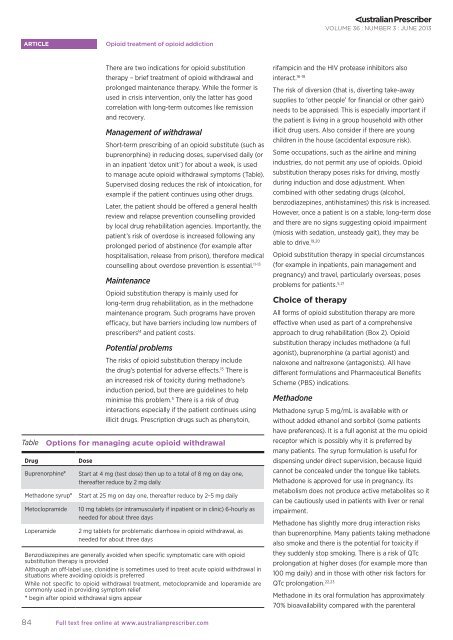download the full PDF issue - Australian Prescriber
download the full PDF issue - Australian Prescriber
download the full PDF issue - Australian Prescriber
You also want an ePaper? Increase the reach of your titles
YUMPU automatically turns print PDFs into web optimized ePapers that Google loves.
VOLUME 36 : NUMBER 3 : JUNE 2013<br />
ARTICLE<br />
Opioid treatment of opioid addiction<br />
There are two indications for opioid substitution<br />
<strong>the</strong>rapy – brief treatment of opioid withdrawal and<br />
prolonged maintenance <strong>the</strong>rapy. While <strong>the</strong> former is<br />
used in crisis intervention, only <strong>the</strong> latter has good<br />
correlation with long-term outcomes like remission<br />
and recovery.<br />
Management of withdrawal<br />
Short-term prescribing of an opioid substitute (such as<br />
buprenorphine) in reducing doses, supervised daily (or<br />
in an inpatient ‘detox unit’) for about a week, is used<br />
to manage acute opioid withdrawal symptoms (Table).<br />
Supervised dosing reduces <strong>the</strong> risk of intoxication, for<br />
example if <strong>the</strong> patient continues using o<strong>the</strong>r drugs.<br />
Later, <strong>the</strong> patient should be offered a general health<br />
review and relapse prevention counselling provided<br />
by local drug rehabilitation agencies. Importantly, <strong>the</strong><br />
patient’s risk of overdose is increased following any<br />
prolonged period of abstinence (for example after<br />
hospitalisation, release from prison), <strong>the</strong>refore medical<br />
counselling about overdose prevention is essential. 11-13<br />
Maintenance<br />
Opioid substitution <strong>the</strong>rapy is mainly used for<br />
long-term drug rehabilitation, as in <strong>the</strong> methadone<br />
maintenance program. Such programs have proven<br />
efficacy, but have barriers including low numbers of<br />
prescribers 14 and patient costs.<br />
Potential problems<br />
The risks of opioid substitution <strong>the</strong>rapy include<br />
<strong>the</strong> drug’s potential for adverse effects. 15 There is<br />
an increased risk of toxicity during methadone’s<br />
induction period, but <strong>the</strong>re are guidelines to help<br />
minimise this problem. 5 There is a risk of drug<br />
interactions especially if <strong>the</strong> patient continues using<br />
illicit drugs. Prescription drugs such as phenytoin,<br />
Table Options for managing acute opioid withdrawal<br />
Drug<br />
Buprenorphine*<br />
Dose<br />
Start at 4 mg (test dose) <strong>the</strong>n up to a total of 8 mg on day one,<br />
<strong>the</strong>reafter reduce by 2 mg daily<br />
Methadone syrup* Start at 25 mg on day one, <strong>the</strong>reafter reduce by 2–5 mg daily<br />
Metoclopramide<br />
Loperamide<br />
10 mg tablets (or intramuscularly if inpatient or in clinic) 6-hourly as<br />
needed for about three days<br />
2 mg tablets for problematic diarrhoea in opioid withdrawal, as<br />
needed for about three days<br />
Benzodiazepines are generally avoided when specific symptomatic care with opioid<br />
substitution <strong>the</strong>rapy is provided<br />
Although an off-label use, clonidine is sometimes used to treat acute opioid withdrawal in<br />
situations where avoiding opioids is preferred<br />
While not specific to opioid withdrawal treatment, metoclopramide and loperamide are<br />
commonly used in providing symptom relief<br />
* begin after opioid withdrawal signs appear<br />
rifampicin and <strong>the</strong> HIV protease inhibitors also<br />
interact. 16-18<br />
The risk of diversion (that is, diverting take-away<br />
supplies to ‘o<strong>the</strong>r people’ for financial or o<strong>the</strong>r gain)<br />
needs to be appraised. This is especially important if<br />
<strong>the</strong> patient is living in a group household with o<strong>the</strong>r<br />
illicit drug users. Also consider if <strong>the</strong>re are young<br />
children in <strong>the</strong> house (accidental exposure risk).<br />
Some occupations, such as <strong>the</strong> airline and mining<br />
industries, do not permit any use of opioids. Opioid<br />
substitution <strong>the</strong>rapy poses risks for driving, mostly<br />
during induction and dose adjustment. When<br />
combined with o<strong>the</strong>r sedating drugs (alcohol,<br />
benzodiazepines, antihistamines) this risk is increased.<br />
However, once a patient is on a stable, long-term dose<br />
and <strong>the</strong>re are no signs suggesting opioid impairment<br />
(miosis with sedation, unsteady gait), <strong>the</strong>y may be<br />
able to drive. 19,20<br />
Opioid substitution <strong>the</strong>rapy in special circumstances<br />
(for example in inpatients, pain management and<br />
pregnancy) and travel, particularly overseas, poses<br />
problems for patients. 5,21<br />
Choice of <strong>the</strong>rapy<br />
All forms of opioid substitution <strong>the</strong>rapy are more<br />
effective when used as part of a comprehensive<br />
approach to drug rehabilitation (Box 2). Opioid<br />
substitution <strong>the</strong>rapy includes methadone (a <strong>full</strong><br />
agonist), buprenorphine (a partial agonist) and<br />
naloxone and naltrexone (antagonists). All have<br />
different formulations and Pharmaceutical Benefits<br />
Scheme (PBS) indications.<br />
Methadone<br />
Methadone syrup 5 mg/mL is available with or<br />
without added ethanol and sorbitol (some patients<br />
have preferences). It is a <strong>full</strong> agonist at <strong>the</strong> mu opioid<br />
receptor which is possibly why it is preferred by<br />
many patients. The syrup formulation is useful for<br />
dispensing under direct supervision, because liquid<br />
cannot be concealed under <strong>the</strong> tongue like tablets.<br />
Methadone is approved for use in pregnancy. Its<br />
metabolism does not produce active metabolites so it<br />
can be cautiously used in patients with liver or renal<br />
impairment.<br />
Methadone has slightly more drug interaction risks<br />
than buprenorphine. Many patients taking methadone<br />
also smoke and <strong>the</strong>re is <strong>the</strong> potential for toxicity if<br />
<strong>the</strong>y suddenly stop smoking. There is a risk of QTc<br />
prolongation at higher doses (for example more than<br />
100 mg daily) and in those with o<strong>the</strong>r risk factors for<br />
QTc prolongation. 22,23<br />
Methadone in its oral formulation has approximately<br />
70% bioavailability compared with <strong>the</strong> parenteral<br />
84<br />
Full text free online at www.australianprescriber.com
















